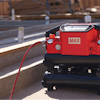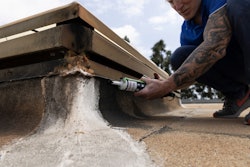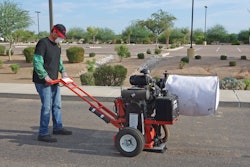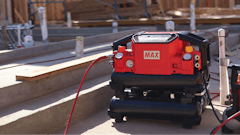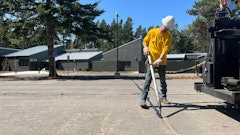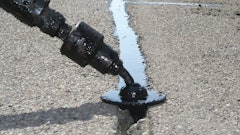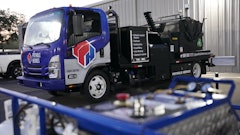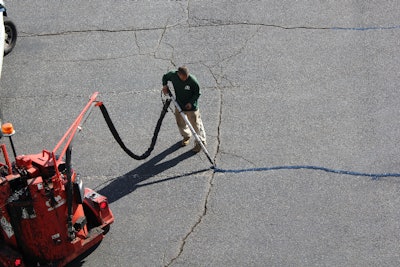
When crack sealing, you need to make sure you have the proper materials to ensure a safe and long lasting crack repair. The information in this article is based off of American Society for Testing and Materials (ASTM) research. The ASTM was formed to develop international standards for materials, products, systems and services used in construction, manufacturing and transportation industries. ASTM has developed more than 12,000 ASTM standards that are used around the world to improve product quality.
ASTM and the American Association of State Highway Transportation Officials (AASHTO) created a material specification and description called D6690 or M324. These specifications describe sealants that meet the specified requirements.
Under these specifications there are basically four standards for sealcoating materials contractors should be aware of (Type I, II, III, and IV) included with differing low and high temperature properties for use in varied climates.
Standard Breakdowns
According to the ASTM, when selecting a sealant, “The sealant shall be composed of a mixture of materials that will form a resilient and adhesive compound capable of effectively sealing joints and cracks in concrete and asphaltic pavements against the infiltration of moisture and foreign material throughout repeated cycles of expansion and contraction with temperature changes, and that will not, at ambient temperatures, flow from the joint or be picked up by vehicle tires. The material shall be capable of being brought to a uniform pouring consistency suitable for completely filling the joints without inclusion of large air holes or discontinuities and without damage to the material. It shall remain relatively unchanged in application characteristics for at least 6 h at the recommended pouring temperature in the field.”
The selection of your sealant type should follow the ASTM types below.
ASTM D6690, Type I (formerly ASTM D1190):
The ASTM D1190, “Standard Specification for Concrete Joint Sealer, Hot-Applied Elastic Type” specification was originally published in 1952. Although the title referenced concrete joint sealer, materials meeting this specification have been used for many years, and are currently used for crack sealing in asphalt concrete pavements.
Specification limits include bond testing at –18° C for 50% extension, 5mm maximum flow at 60° C, and 90 maximum cone penetration at 25° C. Products meeting the specification have provided lasting field performance in moderate climates which do not commonly drop below –22° C in the winter, or commonly exceed 40° C in the summer.
ASTM D6690, Type II (formerly ASTM D3405):
The ASTM D3405, “Standard Specification for Joint Sealants, Hot-Applied, for Concrete and Asphalt Pavements,” specification was originally published in 1975. This specification has stricter low and high temperature testing requirements than ASTM D6690, Type I, and incorporates resilience to indicate elasticity.
Bond testing is performed at -29° C for 50% extension, and the flow limit at 60° C is 3mm. The resilience requirement is 60% minimum. Products meeting this specification require greater degrees of modification than products meeting the Type I specification. AASHTO M301 is equivalent to the Type II specification.
Products meeting the Type II specification are typically used in moderate to cold climates which do not commonly experience winter temperatures below –28° C or summer temperatures above 40° C. LTPPBIND 98% climates applicable for Type II sealant range up to 64° C and from -16° C to -28° C.
Sealants meeting the Type II specification have provided good performance for up to 4.5 years in moderate to cold climates. In very cold climates where temperatures drop below –28° C, and transverse cracks move more than approximately 10 mm, however, the performance capabilities of Type II sealants are exceeded.
ASTM D6690, Type III (formerly Federal Specification SS-S-1401C):
This sealant is similar to Type II, except has added water immersed bond testing and aged resilience. The sealant is functionally equated to Type II products and is used in the same applications.
ASTM D6690, Type IV:
This material did not previously have an ASTM designation, but was commonly referred to as Low Modulus ASTM D3405 sealant by several states in colder climates. The low modulus modification requires bond testing at –29° C using 200% extension instead of 50%, and increases the penetration requirement to 90 to 150 instead of 90 maximum.
Other requirements of the Type II specification remain the same. These modifications result in softer sealants with greatly improved low temperature extension capabilities, compared to Type I, II or III sealants. Several states have their own version of the low modulus product types with some also requiring cone penetration at –18° C of 18 to 80, 25 or 40 minimum.
Products meeting the Type IV specification require an even higher degree of modification than Type II materials, and represent the highest degree of performance and temperature susceptibility modification available in asphalt based crack sealing products. These types of sealants are typically used in cold to very cold climates which commonly drop below –28° C in the winter, but do not generally exceed 35° C in the summer. In the colder climates Type IV sealants have provided good performance, even in cracks which move greater than 10 mm. Type IV sealants are soft and should not be used in warm climates.




